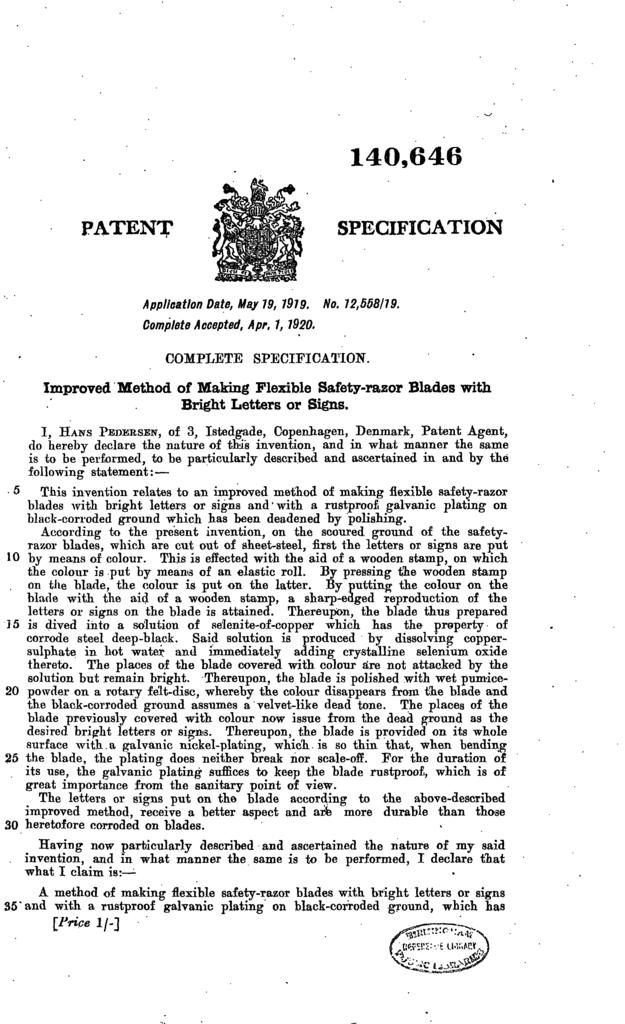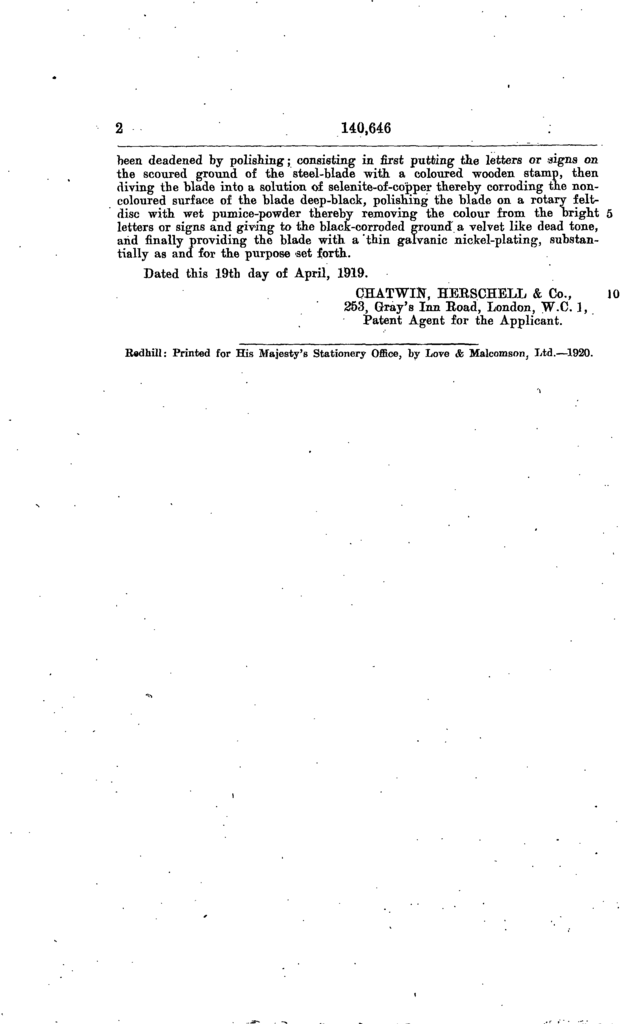A long title for a shortish post. Sometimes when I am digging trough patents online, I find one that is only tangentially related to shaving, but still interesting enough to post about. This, from a fellow Scandinavian, is one of those. Touted as an improved way to adorn a razor blade with bright letters or signs, the described method should work just as well on any steel item.
That said, this is a case – I believe – of “don’t do this at home”. The patent calls for the use of vitriol of copper1 and selenium oxide.2 Neither substance is particularly good for you in moderate to large doses.
The patent text
That said, let us have a look at the actual patent:
I, HANS PEDERSEN, of 3. Istedgade, Copenhagen, Denmark, Patent Agent, do hereby declare the nature of this invention, and in what manner the same is to be performed, to be particularly described and ascertained in and by the following statement:
This invention relates to an improved method of making flexible safety-razor blades with bright letters or signs and’ with a rustproof galvanic plating on black-corroded ground which has been deadened by polishing.
According to the present invention, on the scoured ground of the safetyrazor blades, which are cut out of sheet-steel, first the letters or signs are put by means of colour. This is effected with the aid of a wooden stamp, on which the colour is put by means of an elastic roll. By pressing the wooden stamp on the blade, the colour is put on the latter. By putting the colour on the blade with the aid of a wooden stamp, a sharp-edged reproduction of the letters or signs on the blade is attained. Thereupon, the blade thus prepared is dived into a solution of selenite-of-copper which has the property of corrode steel deep-black. Said solution is produced by dissolving coppersulphate in hot water and immediately adding crystalline selenium oxide thereto. The places of the blade covered with colour are not attacked by the solution but remain bright. Thereupon, the blade is polished with wet pumicepowder on a rotary felt-disc, whereby the colour disappears from the blade and the black-corroded ground assumes a velvet-like dead tone. The places of the blade previously covered with colour now issue from the dead ground as the desired bright letters or signs. Thereupon, the blade is provided on its whole surface with a galvanic nickel-plating, which is so thin that, when bending the blade, the plating does neither break nor scale-off. For the duration of its use, the galvanic plating suffices to keep the blade rustproof, which is of great importance from the sanitary point of view.
The letters or signs put on the blade according to the above-described improved method, receive a better aspect and are more durable than those heretofore corroded on blades.
Having now particularly described and ascertained the nature of my said invention, and in what manner the same is to be performed, I declare that what I claim is:
A method of making flexible safety-razor blades with bright letters or signs and with a rustproof galvanic plating on Hack-corroded ground, which has been deadened by polishing; consisting in first putting the letters or signs on the scoured ground of the steel-blade with a coloured wooden stamp, then diving the blade into a solution of selenite-of-copper thereby corroding the noncoloured surface of the blade deep-black, polishing the blade on a rotary feltdisc with wet pumice-powder thereby removing the colour from the bright letters or signs and giving to the black-corroded ground a velvet like dead tone, and finally providing the blade with a ‘thin galvanic nickel-plating, substantially as and for the purpose set forth.
British patent 140,646
There were no drawing submitted with this patent, which is a shame. I like patent drawings quite a bit. So in the absence of a drawing, here is a scan of the original document.
So what does that mean, really?
When we peel away the technical language, and the verbose stuff, we’re left with a very simple technique. Start with a shiny surface. Stamp your design on said surface. Dip surface in a chemical that will cause corrosion. Rinse, dry and polish away the ink. And that is about it, you got bright letters on a dark background. The nickel plating Hans Pedersen suggest makes it more durable, but it’s not critical.
I can totally see this method being used to on small production run steel razors. Or for a handle maker who assembles his razors with OEM heads from China or elsewhere. A design with bright letters and signs on black top cap would be an eye draw.
The full patent can be found at Espacenet. If you like reading about old patents and other shaving related oddities, I still have a page full of them.
Footnotes
- More properly known as copper(II) sulfate, this inorganic compound comes in the form of beautiful blue crystals. Oh, and it is quite toxic. Toxic enough to be a viable herbicide and fungicide in fact. Be careful.
- Comes in the forms of selenium dioxide and selenium trioxide. The former is an element your body needs in small doses, but large doses causes nonspecific symptoms. The later is can be lethal in reasonable small doses.


